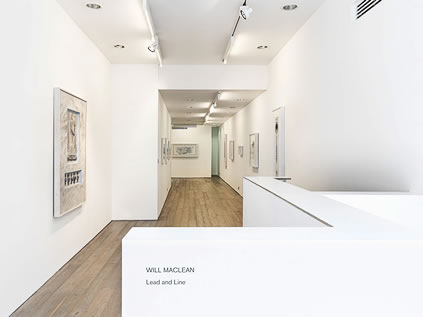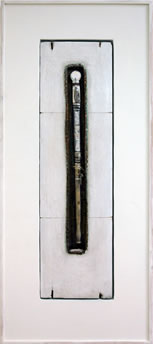Main Gallery
Will Maclean
Lead and Line
5 May - 18 June, 2011
This body of work by Maclean emerges from his new studio in Tayport – a ship shape clapboard room with a view to the sea, a work bench with its multitude of tools and neatly arranged boxes of found objects or collected materials, a library of sketchbooks, and works in progress positioned on strong easels.
His subject matter continues the principal themes that inform his work. Steeped in metaphorical references to the North Atlantic Islands and to the culture of those who live and work by the sea, be they whalers and other mariners, or members of an historic Highland community on St Kilda, the powerful narrative element has now been honed down to the evocative materials used within the works themselves. They suggest, rather than describe their subject, leaving us to understand instinctively, with our imaginations fired.
The novelist and poet John Burnside, who has collaborated with Maclean on occasion, said:
What I love here is the suggestion of a narrative that I cannot quite access, a world glimpsed through fog or tidal water, a lyrical history that – in some time of dreaming, some beyond – weaves land and weather and human making into a single fabric.
Recent voyages to St Kilda, Iceland and the Faroes, with their mythologies and maritime traditions, have influenced Maclean’s new drawings, as well as constructions such as Shaman Board/Whale Wind Plotter. An object of use by implication, but in reality, an assemblage of found materials, with whale baleen, bone, wood and lead, all brought together in a surround of polished white marble dust, this ‘wind plotter’ makes us almost smell the salt wafting off its dry weathered surface. A companion piece, Shaman Board with Herring Collar is even more elegant and cool, charged with magical properties and hidden rules for catching fish.
The largest work, A Short History of North Rona offers a more complex story, arranged to resemble an altar piece with its lower predella of individual egg shaped forms made from lead, and partly polished to echo centuries of touch. The islanders’ hands would rub a symbolic stone, according to tradition, as a plea for calm weather or a safe birth, and other vital needs.
Mysterious and exquisitely made, the works draw you in to disclose half known things, leaving you always wanting to know more. The restraint, the wit and the sense of homage endow Maclean’s constructions with a humanist appeal that places them in a universal realm reaching far beyond Scotland’s shores. This group of mature, confident creations refers to earlier work but has moved on to where the air is purer, and the distillation more evident.
Art First’s exhibition runs concurrently with Maclean’s major retrospective, Collected Works, 1970 – 2010, at the Fleming Collection, where many pieces are on loan from museums including the Fitzwilliam Museum, Cambridge, the Scottish National Museum of Modern Art, and museum collections in Aberdeen, Dundee, Inverness, as well as five works in Fleming’s own holdings.
An illustrated publication accompanies the retrospective and is available from Art First and the Fleming Collection (13 Berkeley Street, W1).








